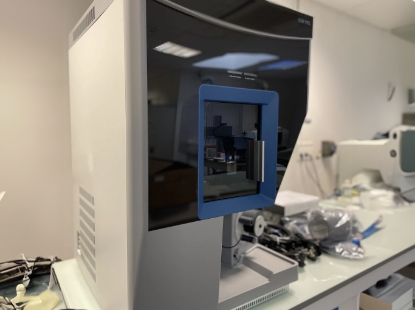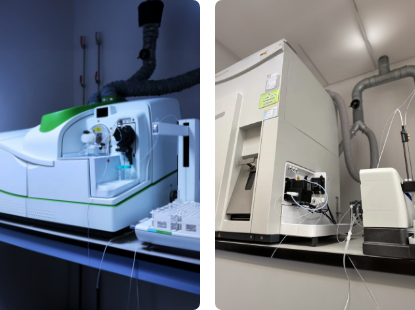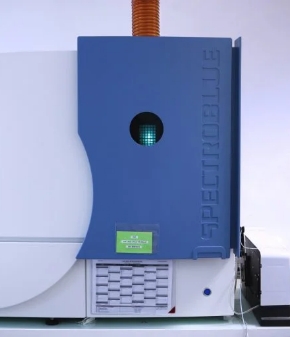ICP analysis (ICP-MS and ICP-AES/ICP-OES) in a laboratory
What is ICP analysis?
ICP, short for "Inductively Coupled Plasma", is an inductively coupled plasma analytical technique used to measure the content of an inorganic element in a sample. This technique is applicable to all types of elemental chemical elements.
ICP sample analysis consists of several steps. Firstly, the solid sample must be dissolved using a strong acid, a mixture of strong acids or microwaves. This is known as mineralisation. The preparation is then vaporised in argon plasma and heated to very high temperatures. These thermal excitations lead to ionisation and separation of the elements, making it possible to characterise and detect each element, depending on the analysers used.
Some fifteen ICPs to serve your industries
ICPs coupled to Atomic Emission Spectrometers (ICP-AES or ICP-OES) measure the wavelengths emitted by ions.
Sensitivity: High for high and medium concentrations.
Applications: Quantitative analysis of elements and traces, and industrial quality control.

ICP coupled with Mass Spectrometers (ICP-MS or ICP-MS/MS) for the analysis of elements according to their charge and mass.
Sensitivity: Very high, suitable for traces and ultra-traces.
Applications: Trace and ultra-trace analysis, e.g. for the environment or pharmaceuticals.


Did you know?
ICP MS-MS is a technique identical to ICP-MS, which uses new intermediate gases to suppress powerful interferences, even in the most difficult matrices. This technique also has an even lower detection limit than conventional ICP. It can even be used to measure certain alkalis at very low quantification limits.
FILAB is the first independent, private laboratory in France to be equipped with an ICP-MS/MS.
Our services
Our ICP analysis
Heavy metal testing is a laboratory method used to identify and quantify the metals contained in a sample.
The ICH Q3D Directive provides for an initial risk assessment phase, based on document analysis or analytical screening in the laboratory, including qualitative and semi-quantitative screening and the determination of impurities by ICP-AES and ICP-MS.
Measuring the chemical composition of a sample involves the precise analysis of the constituents of a sample to determine its exact composition using ICP.
Checking the conformity of a formula or material ensures that it complies with the applicable standards and regulations. To check your sample, ICP-MS and ICP-AES can meet your needs.
Poor metals analysis assesses and quantifies abundant but economically less valuable metals, using techniques such as ICP-MS, ICP-OES or ICP-AES to guarantee the quality and conformity of materials.
The identification of catalyst residues by ICP makes it possible to detect and quantify traces of catalytic substances in a sample.
A deposit or pollution may be metallic, mineral or organic in nature.
The approval of a new mineral material consists of officially validating its characteristics and its use in accordance with the standards and regulations in force.
Single Particle SP-ICP-MS analyses of nanoparticles enable individual nanoparticles in a sample to be characterised and quantified, offering unprecedented precision on their size and concentration.
Our expertise by ICP
Tailor-made development of analytical methods, providing the human and technical resources to meet your needs.
We facilitate the transfer of analytical methods to your laboratories, ensuring a smooth and efficient transition for your team.
We validate protocols in accordance with current guidelines, guaranteeing their compliance with current standards and regulations.
We offer tailor-made training courses, adapted to the specific needs of our customers, to help them master the ICP analysis technique.
Our FAQs
ICP coupled with atomic emission spectrometers (ICP-AES) is an analytical tool that can be used for the elemental analysis of samples. The combination of ICP and AES provides a highly sensitive and accurate method for analysing the concentrations of many different elements present in a sample. The technique is widely used in the metallurgy, pharmaceutical and food industries, etc. ICP-AES has been widely adopted by laboratories around the world because of its accuracy and cost-effectiveness.
This method involves introducing a sample into an ICP source that excites the atoms in the sample with an electric arc or laser beam to produce characteristic emission lines based on the atomic structure of each atom present. These emission lines are measured and analysed to determine the concentration of each element in the sample. The ICP-AES method is capable of detecting most elements at concentrations as low as parts per million.
In addition to its accuracy and cost-effectiveness, one of the advantages of the ICP-AES method is that it can be used on a variety of sample types - solid samples, liquid samples or even gases can be analysed. It also requires minimal sample preparation and very little instrument maintenance. For these reasons, ICP-AES has become one of the most popular techniques for elemental analysis in many industries.
Inductively Coupled Plasma (ICP) spectrometry is a technique used to measure the concentration of elements in samples. It involves introducing a sample into an ICP source, which excites the atoms in the sample with an electric arc or laser beam and produces characteristic emission lines based on the atomic structure of each element present. These emission lines can then be measured and analysed to determine the concentration of each element in the sample. ICP is an accurate and cost-effective method for elemental analysis and is widely used by laboratories around the world.
ICP spectroscopy has many applications in different sectors and fields. It can be used to analyse soil, wastewater, food and other environmental samples. It is widely used in the pharmaceutical industry to measure trace elements in drugs, as well as for quality assurance purposes. ICP spectroscopy can also be used in forensics and archaeology to analyse samples from crime scenes or ancient artefacts. It is also a valuable tool for the analysis of precious metals, helping companies to determine the exact composition of gold, silver and platinum alloys. In general, ICP spectroscopy can be used for many different analytical applications requiring elemental analysis.
The combination of ICP-AES and ICP-MS makes it possible to determine a wide range of inorganic elements and elemental impurities in a single run, with extreme reliability and accuracy (in the ppt to ppb range, depending on the matrix).
ICP-MS and ICP-MS/MS are two techniques for the accurate identification and quantification of chemical elements, even at very low concentrations.
While ICP-MS is widely adopted for its ability to detect trace elements in a multitude of materials, ICP-MS/MS stands out for its ability to eliminate interferences and provide more reliable results in complex matrices. This latter feature makes ICP-MS/MS particularly interesting when the purity and exact composition of materials are critical, as in the pharmaceutical industry for drug safety and contaminant control.
Here is a comparative table of the four analysis methods offered by the FILAB laboratory: ICP-MS, ICP-MS/MS, ICP-AES, and ICP-OES.
| Technical method | Principle | Sensitivity | Interference management | Typical applications |
| ICP-MS | Inductively Coupled Plasma Mass Spectrometry | Very high | Limited by spectral interference | Trace and ultra-trace analysis, environment, pharmaceuticals. |
| ICP-MS/MS | Inductively Coupled Plasma Tandem Mass Spectrometry | Extremely high | Excellent thanks to the MS/MS step | Complex matrices, environment, bioanalysis, pharmaceuticals. |
| ICP-AES | Inductively Coupled Plasma Atomic Emission Spectroscopy | High | Subject to spectral interference, | Quantitative analysis of elements, quality control, environment. Metals, alloys, aqueous solutions |
| ICP-OES | Inductively Coupled Plasma Optical Emission Spectroscopy | High | Subject to spectral interference, | Analysis of major and trace elements, metallurgy, environment. Glass, ceramics, metals |
ICP analysis is mainly used to measure the presence and concentration of metals and trace elements in various types of materials.
It is a powerful technique commonly applied in quality control, R&D, regulatory compliance, and failure analysis.
Industries such as pharmaceuticals, cosmetics, metallurgy, and environmental testing rely on it to ensure safety, purity and conformity.
While both techniques use a plasma source to atomize and excite the elements, ICP-MS measures the mass-to-charge ratio of ions and achieves extremely low detection limits.
This makes it the go-to method for ultra-trace metal detection. ICP-AES, on the other hand, detects the light emitted by excited atoms and is faster for routine analyses at higher concentrations. FILAB offers both, depending on your needs.
ICP analysis can be performed on a wide variety of materials, including solutions, powders, alloys, plastics, polymers, oils, cosmetics, and pharmaceutical products. Whether your sample is organic or inorganic, our team adapts the sample preparation accordingly.
ICP-MS is capable of detecting most elements down to parts-per-trillion levels, depending on the matrix and the element. This is crucial in cases where contamination must be avoided or strictly quantified.
Yes, all of our ICP-MS and ICP-AES analyses are carried out under ISO 17025 accreditation (COFRAC). This ensures that results are produced with verified methods, consistent traceability and in line with international quality standards.




to contact our team.




